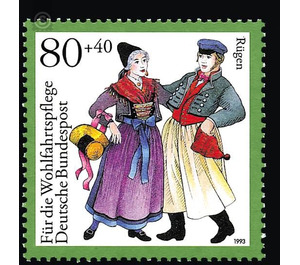welfare: German national costumes - Germany / Federal Republic of Germany 1993 - 80 Pfennig
Theme: Devices, Items & Instruments
| Country | Germany / Federal Republic of Germany |
| Issue Date | 1993 |
| Face Value | 80.00 |
| Color | multi-colored green white |
| Perforation | K 13 3/4 |
| Printing Type | Multicolor offset printing |
| Stamp Type | Postage stamp |
| Item Type | Stamp |
| Chronological Issue Number | 1569 |
| Chronological Chapter | GER-BRD |
| SID | 543461 |
| In 30 Wishlists | |
The training of the costume, the regionally influenced clothing in the rural area, took place in relation to the fashionable costume of the nobility and the urban bourgeoisie. Dress codes issued by the authorities stipulated in detail up to the 18th century which materials and ornaments were allowed to decorate the robes of the individual stands. Official, professional and festive masses were an expression of hierarchies in the court, in the city and in the countryside. Since 1800, with the development of modern administrations, the expansion of transport routes and the increasing mobility of the population, tendencies to standardize clothing have been increasing. During the 19th century, as part of the general interest in history developed a special fondness for the village dressage and their fixation in traditional costumes and books. Traditional costumes and costumes went on pageants, princely peasant weddings and bourgeois farmers' balls hand in hand. Clothing traditions and often alleged traditions of local dress characterized peoples, tribes, regions and places. This newly defined character function of costume often led to the rigid definition of regional and local clothing habits as an element of history preservation. Many of the collections of folk costumes collected in the folklore museums date back to the 19th and early 20th centuries, to the same extent traditional costumes and traditional books. These testimonies preserve especially the holiday dress of the rural population, not the everyday clothes. In the epoch of industrialization, a special market for products was developed, which served to intensify regional clothing culture. Embroidered semi-finished goods, as well as richly patterned national costumes, were industrially produced and delivered to remote consumers in the countryside through the densifying traffic network. Clothing was no longer "self-made, self-made," but new product offerings changed clothing habits in the countryside. The jewelry of the women on Rügen (Mecklenburg-Vorpommern) consisted, as often in other coastal areas usual, often from amber needles to the holding together of the Brusttücher and amber ear rings. For men's costume, the wide white trousers are characteristic. This garment typical of the seafaring population was taken over into the state in accordance with some other professional uniforms evolving from workwear. The leg dress, which was once widespread on the Baltic Sea, has been preserved on Rügen until the 19th century. (Text: Edith Luther, Germanic National Museum, Nuremberg)


